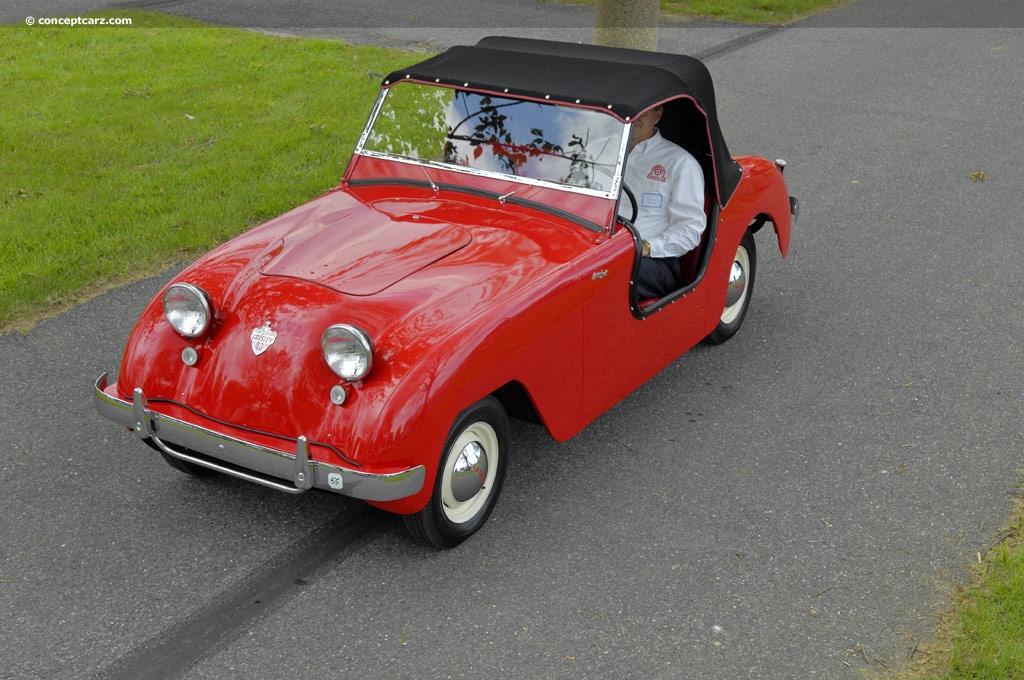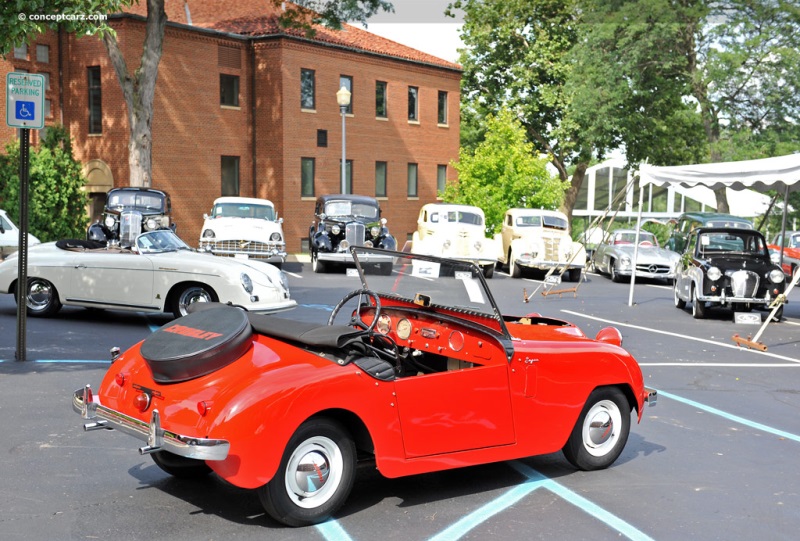Powel Crosley was a believer in small cars and even tried to build and market a cyclecar in the early 1900s but the cyclecar market was decimated by the arrival of the Model T. Instead, he turned his attention to refrigerators and radios, turning his Cincinnati business into one of the success stories of the Depression-era. He was also the owner of Crosley Broadcasting Corporation, owner of the Cincinnati Reds and among other things. Having made a fortune, he returned to the small car segment again in the late 1930s with a small 2-cylinder air-cooled car. Sales of Powell Crosley's new car were slow despite the initial offering of a convertible, sedan, and later, station wagon, pickup, and panel delivery body styles. Production was interrupted by World War II, but during the war, Crosley manufactured the four-cylinder COBRA industrial engine for the United States Government, which helped to put the company on solid financial footing. World War II also brought Crosley buyers due to gasoline rationing and the nearly 50 miles per gallon the Crosley could achieve, helping to keep the company afloat. 
Roadster
View info and historyWhile working on a U.S. Navy project during the war, Crosley used a block of brazed copper and sheet steel to develop the overhead cam four-cylinder known as the COBRA engine. When peacetime resumed, civilian postwar cars were installed with these 60 lb engines. This five-main-bearing, 44 cubic-inch engines developed 26.5 horsepower at 5,400 RPM. During the war, these engines had powered everything from Mooney Mite airplanes to truck refrigerators but it was also subject to electrolysis that resulted in holes developing in cylinders. This led to a poor reputation for the company, and even though the problem was resolved and Crosley offered to replace failed engines, its reputation had become tarnished, causing sales to suffer. The stamped copper-steel block was shortly updated to a cast-iron block designed and built by Crosley in 1949. Keeping the original dimensions, this engine's additional weight over the front wheels added much more stability to the vehicle.To help revive sales, the Hot Shot roadster was introduced in 1949, and over a four-year period, approximately 2,500 examples were produced. They were simple and light, with doors being optional, and recognized as America's first postwar production sports car. The two-passenger lightweight roadster was powered by a new cast iron engine, or CIBA, developed by Crosley, which replaced the previous sheet metal block, the cause of his ills. The Hot Shot won at Sebring, Grand de la Suisse, and SCCA competition. It weighs 1200 lbs and could be stripped down to 900 lbs and reach speeds of up to 90 mph. Victor Sharpe, Jr. of Tampa, Florida, had entered a Crosley Hot Shot Roadster in the inaugural Sam Collier Memorial Sebring Grand Prix of Endurance in 1950, driven by Fritz Koster and Ralph Deshon. Sebring that year was contested on an index of performance formula where speed was balanced by efficiency. The little Hot Shot, although it was lapped nineteen times by the second-place Ferrari 166 of Jim Kimberly and Marshall Lewis, took the trophy, demonstrating the Crosley's combination of performance and economy.Styling featured 'bug-eye' headlights set high on a sloping nose, a flat, one-piece windshield, door cutouts, a rear-deck mounted spare tire, and bucket seats. They were 145 inches long, powered by a 725cc engine backed by a three-speed manual transmission, had a live axle suspension with semi-elliptical-springs in the front and coil springs with quarter ellipticals in the rear, four-wheel hydraulic brakes, and rode on steel wheels with chrome hubcaps wrapped with whitewall tires. The 44 cubic-inch single overhead camshaft inline four-cylinder engine used a Tillotson one-barrel carburetor and developed 26 horsepower at 5,400 RPM. At $849, 752 of the new roadsters were produced during the inaugural model year. Designed and built with European influences, the Hotshot was on par with the likes of Triumph, MG, Fiat, and other brands with sporty personas. 
Roadster
Chassis #: VC302278
View info and history
Auction entries : 1A trim level above the Hot Shot was added the following year called the Super Sport, offering better trim and a folding top. Later 1951 and 1952 Super Sports were distinguishable from the early Hot Shots by having full doors, while the Hot Shots had cut-down sides with either no doors or removable half doors. The first 'Super Hot Shot' for 1949 was available for $849. The main variances between the previous model and the Hot Shot was the 'Super' side script, the folding top rather than assembled, and the red trim around the cockpit. 9-inch hydraulic brakes became standard in June, replacing the four-wheel Goodyear-Hawley aircraft-style disc brakes. This change was implemented due to the salt-filled country roads that caused freezing-up problems with the brakes.Designer Frank Lloyd Wright favored these cars and owned a fleet of them, all painted in red. Total Crosley production fell from a high of 24,781 cars in 1949 to just 1,522 in 1952, when the factory closed for the Fourth of July and never reopened.Many innovations characterized Crosley's post-war years, including the first mass-market single overhead camshaft (SOHC) engine, the first use of the term Sport Utility, and the first American car to be fitted with four-wheel disc brakes. In spite of a number of firsts to Crosley's credit, its use of a military engine in a civilian vehicle did not go very well, and as the world began to recover from World War II and the Big Three began regrouping themselves into automobile production, Crosley sales began to fade. Before long, the Big Three were offering larger, more powerful, and luxuriously equipped cars for just a few dollars more than any Crosley. The company hoped the Hotshot and a special all-wheel-drive farm and town vehicle would stimulate sales but did little to slow the decline. Crosley's existence in the automotive segment was brief, but during that time, they introduced a number of innovations and brought America its first sports car: the Hotshot.
by Daniel Vaughan | Jan 2021

Roadster
View info and history

Roadster
Chassis #: VC302278
View info and history
Auction entries : 1
by Daniel Vaughan | Jan 2021
Related Reading : Crosley Hot Shot History
Powel Crosley, a manufacturer of radios and refrigerators, began manufacturing automobiles in 1940. The Crosley cars were tiny, quirky, and not very popular. The Hot Shot was Americas first post-war sports car. With only 26.5 horsepower, the car was not very fast, but it handled well and offered an elemental wind-in-face experience typical of British MGs. Only 2,498 Hot Shots were built between....
Continue Reading >>
Continue Reading >>
Related Reading : Crosley VC History
Introduced in 1949, as a Super Hot Shot, the Crosley Hot Shot came with cut down sides without doors, or removable half doors. The Hot Shot was available at the low price of %24849. With new styling that included integral fenders, smooth hood, turn indicators (on sedans and convertibles) and sealed-beam headlights in upright pods the 1949 was by far the best car produced by Crosley. An 80-inch wheelbase....
Continue Reading >>
Continue Reading >>
Crosley
Similarly Sized Vehicles
from 1951
Similarly Priced Vehicles
1951 Crosley Hot Shot Vehicle Profiles
Recent Vehicle Additions
Performance and Specification Comparison
Price Comparison
$880 - $985
$1,030
Hot Shot Specification Comparison by Year
Year
Production
Wheelbase
Engine
Prices
Related Automotive News

Le Mans Class-Winning 1969 Porsche 908/02 LH Spyder Headlines Broad Arrow All-Porsche Auction in Partnership with Air|Water in Orange County, California on April 27
Broad Arrow Auctions, a Hagerty (NYSE HGTY) company, is thrilled to announce an exclusive Porsche-only auction in partnership with the first-ever AirWater standalone event. AirWater is the brainchild of Luftgekühlt founder Patrick Long, who is well-known...

The Ultimate Driving Museum Celebrates the 100th anniversary of BMW Motorrad with the BMW Motorcycles: A Century of Innovation exhibit
Runs from May 2023 till January 2024.
Fifty-seven rare and significant vehicles on display.
Located in Greer, SC.
The Ultimate Driving Museum of the BMW CCA Foundation in Greer, SC celebrates the 100th anniversary of BMW Motorrad with an eight mo...

Two-Wheeled Heroes in the heart of the City: Rarest Ducatis to star at London Concours in 2022
Rarest and most significant Ducati motorcycles to be assembled at Londons Honourable Artillery Company this June.
Exceptional examples from the past 50 years will be united at the capitals leading concours delegance event, charting the rich hist...

Volkswagen Golf Alltrack And Sportwagen To End Production In 2019
Golf Alltrack to remain in production through December in Puebla
Upcoming SUVs and ID. family models to provide style and spaciousness in new ways
Herndon, VA — Volkswagen of America announced today that the critically-acclaimed Volkswagen...

VOLKSWAGEN'S NEW TURBO ENGINES AND 2015 GOLF ON DISPLAY AT THE SEMA SHOW
Tuned Jetta sedans featuring new EA888 turbocharged TSI® engines on display in Las Vegas First North American tuned seventh-generation Golf debuts before market launch in 2014
Las Vegas, NV - With U.S. sales having more than doubled...




























